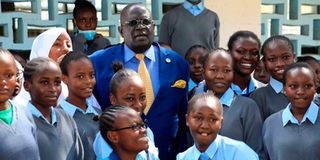Scramble for limited junior secondary school places

Education Cabinet Secretary Prof. George Magoha with Changamwe Secondary School students on August 20, 2022. He commissioned two classrooms which will host the Junior Secondary School students.
The more than 1.28 million learners who will join junior secondary school (JSS) in January next year will compete for limited spaces in top schools.
An almost equal number of learners who are under the 8-4-4 system will join Form One at the same time in a double intake that is expected to stretch school resources, although the government insists there is no cause for worry.
The learners under the competency-based curriculum are currently selecting their preferred schools in an exercise that will close on August 30. However, many parents are still in the dark on how to select JSS institutions as the Ministry of Education has not released any selection and placement guidelines. Education Cabinet Secretary George Magoha had promised to do so three weeks ago. For the first time, the ministry will place learners in private schools based on their selection.
Learners will be placed in secondary schools depending on their performance in the Kenya Primary School Education Assessment, which has replaced the Kenya Certificate of Primary Education exams. The assessment is administered formatively in grades 4,5 and 6, with a summative assessment at the end of Grade 6. The first such assessment will be administered in November.
Curriculum reforms
A report by the task force on enhancing access, relevance, transition, equity and quality for effective curriculum reforms implementation projected that there will be a shortage of 1,489,144 places in secondary schools. This would require 29,783 extra classrooms to fix. The government embarked on construction of 10,000 extra classrooms but the number still falls short.
Besides, the programme does not cater for construction of dormitories and other facilities.
Over the past four years, secondary schools have experienced congestion owing to the introduction of the 100 per cent transition from primary to secondary school. There has been no expansion of infrastructure to match the increase in student numbers.
The worst-hit counties are Kakamega with a gap of 93,703, Bungoma (83,243), Nairobi (83,062), Nakuru (60,214), Kilifi (58,945) and Migori (58,095).
Whereas many parents and learners would prefer top performing schools, these are few and the majority of learners will be admitted to sub-county schools, which are primarily day schools.
In terms of categorisation, there are 112 national, 776 extra-county, 1,301 county, 6,297 sub-county and 1,301 private secondary schools. According to the report, there are 1,803 public boarding secondary schools and 479 private ones. This is against 5,029 public and 432 private day schools. Those that have both boarding and day wings are 390 (private) and 2,245 (public).
Suitable schools
Learners with special needs may also find it challenging to find suitable schools.
However, Education Chief Administrative Secretary Sara Ruto yesterday assured parents that the transition to JSS would be seamless and that the government would expand the capacities of rural schools.
“Some schools are more endowed than others. I think parents feel their children will be more successful if they go to certain learning institutions than others and that is why we are discussing equity,” she said.
Dr Ruto said the ministry had identified schools that lack resources that are key to the implementation of CBC and, as such, capitation funds would be channelled to these institutions to fully equip them. She spoke during the opening of the Kenya-Finland International Conference on Enhancing Education in Mombasa.
It is expected that private schools will add about 5,000 more classrooms for JSS. Some private primary schools have introduced secondary school wings for their learners.
Dr Ruto ruled out a return to the 8-4-4 system as proposed by some stakeholders.






